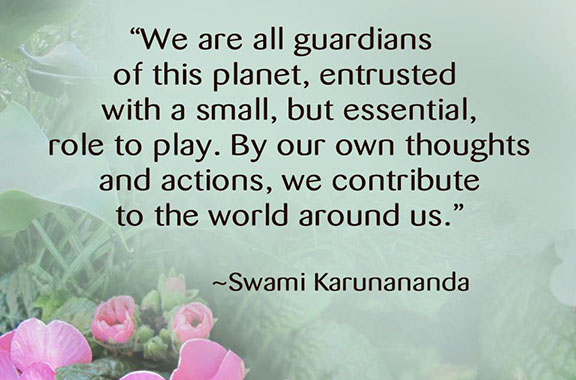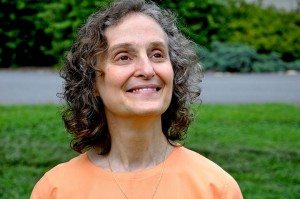 When I think of what it means to really live Yoga, I recall a special visit in late December, in the mid-1970s. I was serving as director of the San Francisco Integral Yoga Institute, and Swami Satchidananda (Sri Gurudev) was coming to California for the celebration of his jayanti (birthday) in San Francisco, and then he would be with us for Christmas and our New Years retreat in Santa Barbara. It registered hardly more than a week on the calendar, but in the intense whirlwind of love and service that was generated, lessons for a lifetime were learned. These lessons can be understood as basic principles for really living Yoga.
When I think of what it means to really live Yoga, I recall a special visit in late December, in the mid-1970s. I was serving as director of the San Francisco Integral Yoga Institute, and Swami Satchidananda (Sri Gurudev) was coming to California for the celebration of his jayanti (birthday) in San Francisco, and then he would be with us for Christmas and our New Years retreat in Santa Barbara. It registered hardly more than a week on the calendar, but in the intense whirlwind of love and service that was generated, lessons for a lifetime were learned. These lessons can be understood as basic principles for really living Yoga.
The staff at the San Francisco IYI was responsible for coordinating all these events, as well as for housing and hosting the many guests who were coming from all over the country for the festivities. Our very modest living spaces had to be modified and shared in new ways. What at first seemed impossible yielded to our persistent and prayerful efforts. The very walls of the house seemed to expand to accommodate all our guests and the hundreds of students who came to receive Sri Gurudev’s blessings. We were few in number, and the task seemed monumental. But by some miracle, everything was accomplished, which brings us to the first principle:
Principle #1: As Sri Gurudev often remarked, “Where there’s a will, there’s a way. Where there’s heart, there’s always room.”
The weekend began auspiciously. In the morning at the Institute, we had a beautiful puja in honor of Sri Gurudev’s jayanti. In the evening, we enjoyed a wonderful program of offerings at a lovely auditorium in the city. The grand finale was an extraordinary slide show in honor of Sri Gurudev’s service. It was so inspiring that, at its conclusion, the entire audience of about seven hundred people jumped to their feet in a standing ovation. This spirit of jubilation continued as some of us proceeded to an Indian restaurant for a late night banquet.
By the time we had finished the meal, it was nearly two in the morning. Gurudev entered an elevator in order to exit the building, and then began calling others to come into the elevator as well. There was a large sign posted inside that read: “Maximum capacity 12 people; do not exceed.” With a distinct air of mischief, he beckoned at least twenty of us into that tiny conveyance. When we were all closely crammed in, Gurudev reached forward and pushed the button. The door closed, the elevator started to move, and, then, with a sudden lurch, stopped between floors.
So, there we were in the wee hours of a Sunday morning, trapped in an elevator with our beloved Gurudev. There were devotees on the floors above and below us, chanting and praying. Others began calling all over the city trying to locate a repairman. At this point, I had the thought: “We don’t know how long we may be in here. The most important thing is to conserve oxygen. We should all be as still as possible.” As if in response to my thought, Gurudev immediately suggested that everyone start chanting Rama, Rama—which is a powerful mantra that kindles the inner fire. So, not only would we be using up the physical oxygen, but on a subtle level, we would be creating a lot of heat, too!
As the minutes passed, people began responding in different ways. Some repeatedly tried pushing the buttons. One person tried to climb out the top of the compartment. Some were calm; others panicked. After about forty minutes, Gurudev gently reached over and pressed the button. The elevator immediately proceeded to the ground level, and we all took a deep, grateful breath as we left the building.
On the way back to the Institute, we were discussing what we had just experienced. Finally, the conclusion was that we were being tested to see how we would respond under trying circumstances, and when the test was over, the elevator resumed working. From this experience, we can glean two more principles:
Principle #2: Realize that there is a purpose behind all that unfolds and have faith in a positive outcome.
Principle #3: When faced with challenging circumstances, know that the moment the karma is purged, the situation will change.
As one of my fellow monks has put it: “If it’s your karma to have a certain illness, it doesn’t matter if you drink nectar, the illness will persist. However, when the karma is drawing to a close, you could even eat dirt, and you would be cured.”
The most important lesson of the weekend for me was yet to come. Gurudev was flying down to Santa Barbara, so we all went to see him off at the airport—well, almost all of us. I noticed that one family that had traveled a great distance to be with Gurudev was not present. Upon returning to the Institute, I found them sitting at the reception desk, greeting students coming for the Hatha Yoga class. They innocently asked when they would be able to see Gurudev, not realizing that we all had just come from the airport. It seems that the scheduled receptionist had asked them to reception in her place, so she could go to the airport herself.
It was clear that this was not a good situation and, as the person in charge, I was going to be held accountable. I sensed that trouble lay ahead, but there was so much to do, I couldn’t really think about it. So, we all piled into our vehicles, formed a caravan, and proceeded to Santa Barbara. The following evening, we celebrated Christmas with Gurudev and the members from all the California IYIs—from San Francisco, Santa Cruz, Los Angeles, and San Diego. After an inspirational movie, I was making announcements about the retreat that was to begin the following day, when I noticed the guest who had been left behind approach Gurudev. As the guest was speaking, Gurudev kept turning and glancing in my direction. It seemed like each time, there was a little more fire in his eyes.
Then suddenly, Gurudev turned to me and spoke: “All your Yoga practices—your Hatha Yoga, pranayama, and meditation are for this purpose: to make you fit to serve others. If ever the opportunity comes to serve, forget those other practices; you can always do them later. Take care of others; that is the most important thing.” His words were deeply impressed on my heart. The following day, I offered my apologies, which Gurudev graciously accepted. A couple of essential lessons were learned:
Principle #4: On life’s journey, we all make mistakes. However great our capacity to err, the power of forgiveness is greater still. As we would wish to be forgiven, we should practice forgiveness toward one another.
Principle #5: Love all, serve all.
This last one, perhaps, is the greatest of all. It was the message of Gurudev’s life. He often quoted the following verse from the Bhagavad Gita: “Tyagat shantir anantaram,” which means: “The dedicated ever enjoy supreme peace.” And he would add, “Therefore, live only to serve.”
He compared formal practice and service to a barber giving a shave. Meditation is like sharpening the razor, and service is like shaving. If you don’t sharpen the razor, you can’t shave well and may even cause harm. If you just spend your time sharpening the razor and don’t shave, what is the point?
This blend of the contemplative and active life was the basis for the way he designed the ashram schedule, as well as the Integral Yoga retreats, and the way he guided students everywhere to bring Yoga into their lives. By beginning the day with formal practice—meditation and Hatha Yoga—we would condition our minds to stay peaceful and our bodies easeful. Additionally, we could have check-in times throughout the day—at noon, dusk, and before retiring—to center ourselves through prayer and meditation. By so doing, we would be fit for service, and our lives would be useful.
He called each and every one of us to dedicate our lives for the sake of the entire creation: “With every minute, every breath, every atom of our bodies, we should repeat this mantra: dedication, dedication, giving, giving, loving, loving. That is the best Yoga, which will bring us permanent peace and joy.” If we do our best to answer this call, then we will really be living Yoga.
About the Author:
 Swami Karunananda is a senior disciple of Sri Swami Satchidananda. In 1975, she was ordained as a monk into the Holy Order of Sannyas. She has had almost 50 years experience teaching all aspects of Yoga and specializes now in workshops, retreats, and teacher training programs that focus on the science of meditation, the philosophy of Yoga, personal transformation, and Yoga breathing techniques for better health and well-being. She developed, and for 30 years has taught, the Integral Yoga Teacher Training programs in Raja Yoga and in Meditation.
Swami Karunananda is a senior disciple of Sri Swami Satchidananda. In 1975, she was ordained as a monk into the Holy Order of Sannyas. She has had almost 50 years experience teaching all aspects of Yoga and specializes now in workshops, retreats, and teacher training programs that focus on the science of meditation, the philosophy of Yoga, personal transformation, and Yoga breathing techniques for better health and well-being. She developed, and for 30 years has taught, the Integral Yoga Teacher Training programs in Raja Yoga and in Meditation.
Swami Karunananda served as president of Satchidananda Ashram–Yogaville in Virginia and in California, as well as director of the Integral Yoga Institutes in San Francisco and in Santa Barbara. She currently serves on the Board of Trustees, and as the chairperson of the Spiritual Life Board at Satchidananda Ashram–Yogaville, Virginia.
Interested in fostering interfaith understanding and harmony, she is featured in the interfaith documentary entitled, With One Voice. She also compiled and edited the Lotus Prayer Book, a collection of prayers from various faith traditions, and Enlightening Tales as told by Sri Swami Satchidananda. She served as contributing editor for The Breath of Life: Integral Yoga Pranayama, as well as a senior writer for the Integral Yoga Magazine. In her book, Awakening: Aspiration to Realization Through Integral Yoga, she describes the spiritual path and provides guidance for the journey.


